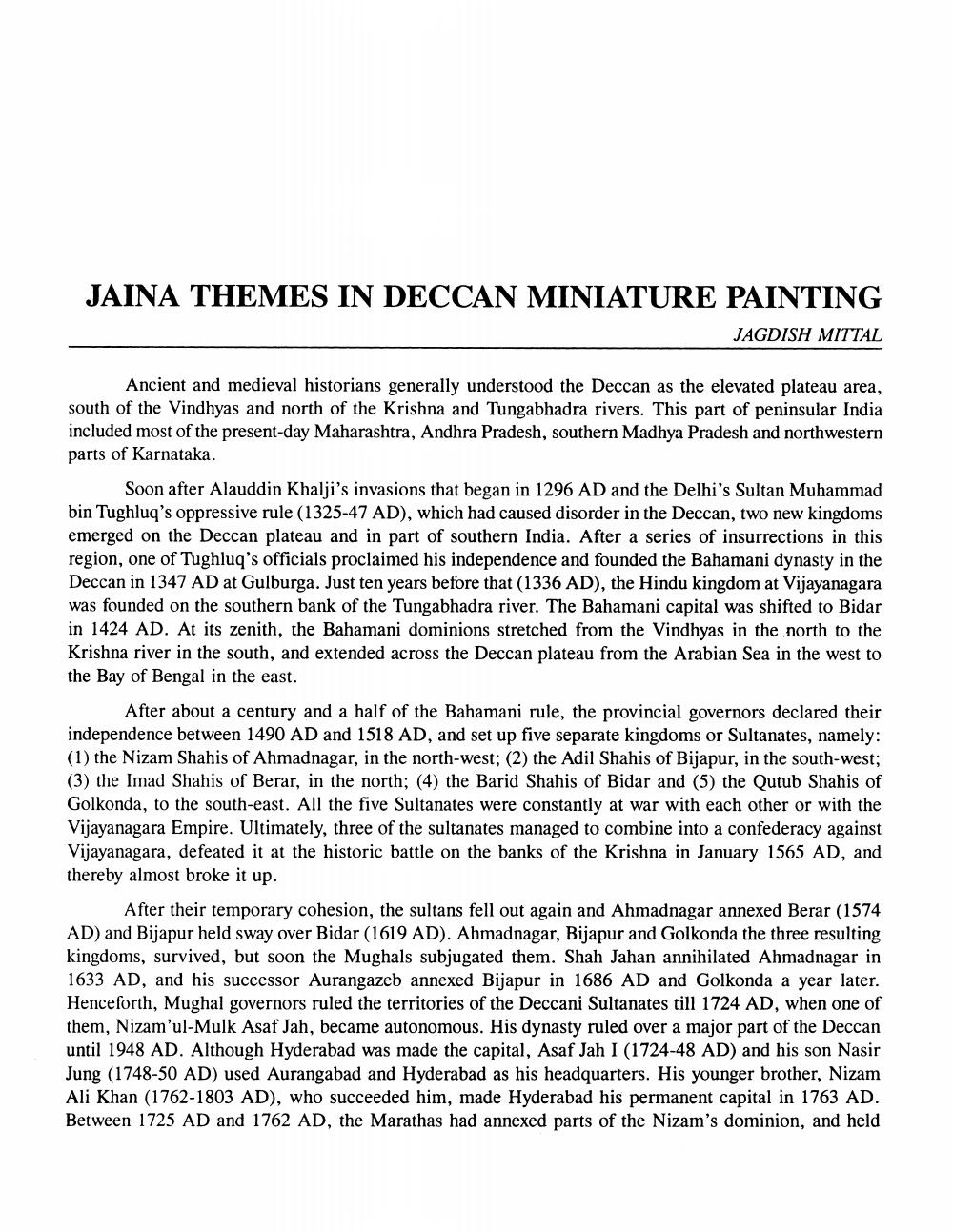________________
JAINA THEMES IN DECCAN MINIATURE PAINTING
JAGDISH MITTAL
Ancient and medieval historians generally understood the Deccan as the elevated plateau area, south of the Vindhyas and north of the Krishna and Tungabhadra rivers. This part of peninsular India included most of the present-day Maharashtra, Andhra Pradesh, southern Madhya Pradesh and northwestern parts of Karnataka.
Soon after Alauddin Khalji's invasions that began in 1296 AD and the Delhi's Sultan Muhammad bin Tughluq's oppressive rule (1325-47 AD), which had caused disorder in the Deccan, two new kingdoms emerged on the Deccan plateau and in part of southern India. After a series of insurrections in this region, one of Tughluq's officials proclaimed his independence and founded the Bahamani dynasty in the Deccan in 1347 AD at Gulburga. Just ten years before that (1336 AD), the Hindu kingdom at Vijayanagara was founded on the southern bank of the Tungabhadra river. The Bahamani capital was shifted to Bidar in 1424 AD. At its zenith, the Bahamani dominions stretched from the Vindhyas in the north to the Krishna river in the south, and extended across the Deccan plateau from the Arabian Sea in the west to the Bay of Bengal in the east.
After about a century and a half of the Bahamani rule, the provincial governors declared their independence between 1490 AD and 1518 AD, and set up five separate kingdoms or Sultanates, namely: (1) the Nizam Shahis of Ahmadnagar, in the north-west; (2) the Adil Shahis of Bijapur, in the south-west; (3) the Imad Shahis of Berar, in the north; (4) the Barid Shahis of Bidar and (5) the Qutub Shahis of Golkonda, to the south-east. All the five Sultanates were constantly at war with each other or with the Vijayanagara Empire. Ultimately, three of the sultanates managed to combine into a confederacy against Vijayanagara, defeated it at the historic battle on the banks of the Krishna in January 1565 AD, and thereby almost broke it up.
After their temporary cohesion, the sultans fell out again and Ahmadnagar annexed Berar (1574 AD) and Bijapur held sway over Bidar (1619 AD). Ahmadnagar, Bijapur and Golkonda the three resulting kingdoms, survived, but soon the Mughals subjugated them. Shah Jahan annihilated Ahmadnagar in 1633 AD, and his successor Aurangazeb annexed Bijapur in 1686 AD and Golkonda a year later. Henceforth, Mughal governors ruled the territories of the Deccani Sultanates till 1724 AD, when one of them, Nizam'ul-Mulk Asaf Jah, became autonomous. His dynasty ruled over a major part of the Deccan until 1948 AD. Although Hyderabad was made the capital, Asaf Jah I (1724-48 AD) and his son Nasir Jung (1748-50 AD) used Aurangabad and Hyderabad as his headquarters. His younger brother, Nizam Ali Khan (1762-1803 AD), who succeeded him, made Hyderabad his permanent capital in 1763 AD. Between 1725 AD and 1762 AD, the Marathas had annexed parts of the Nizam's dominion, and held




